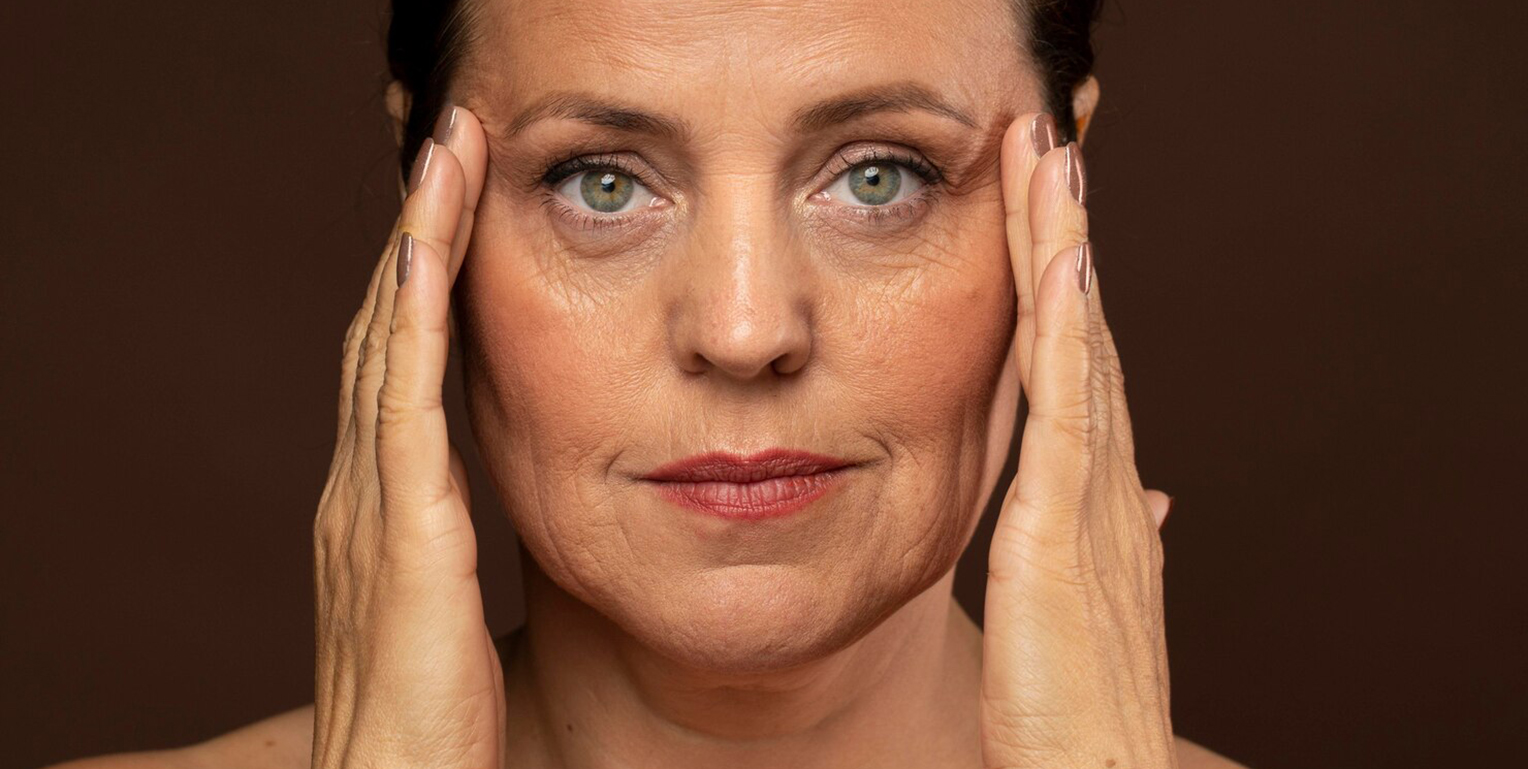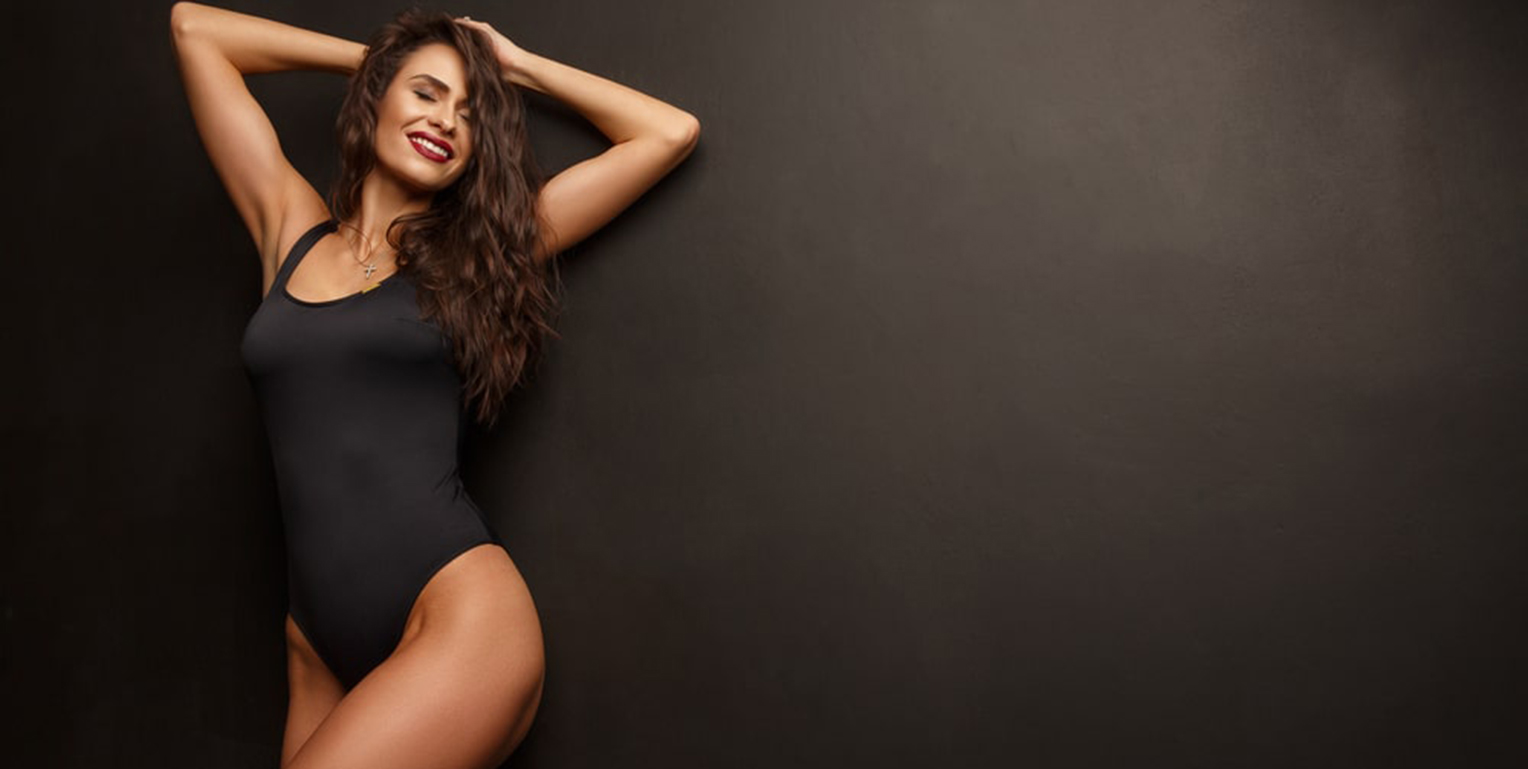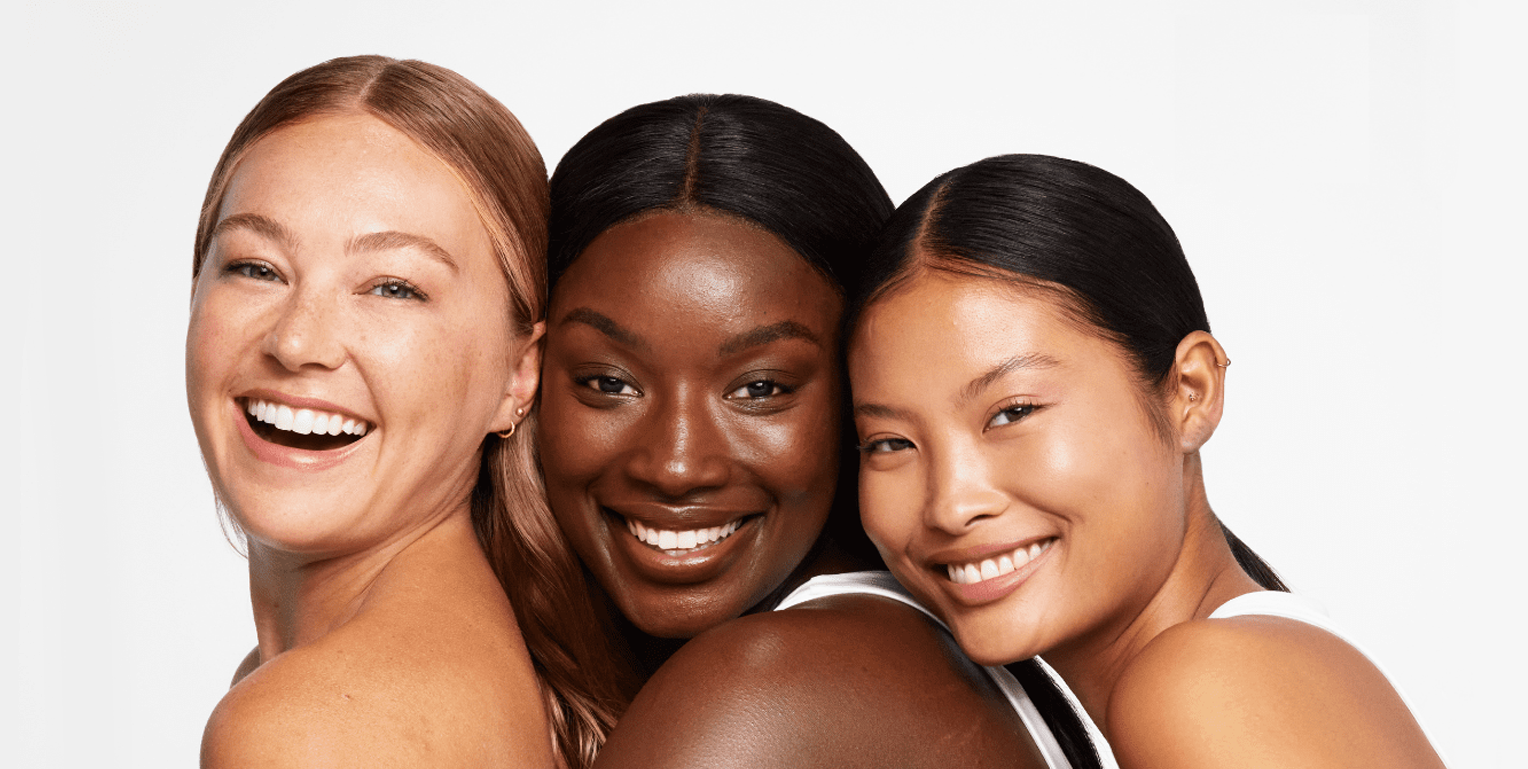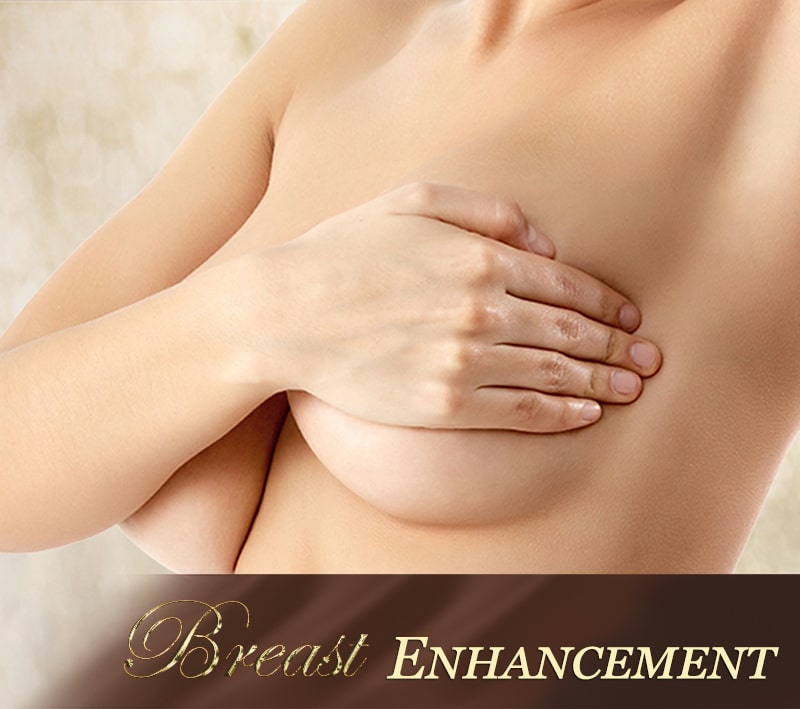
Breast Enlargement using implants, also known as Breast Augmentation or Augmentation Mammaplasty, involves placing an artificial implant into the breast pocket in order to increase the breast’s size, correct asymmetry, improve body contour, or for reconstruction after breast cancer resection. Breast enlargement can also produce a degree of lift where necessary.
Clinical trials have shown that breast implants are a safe technique for breast augmentation and it is by far the most popular procedure requested by women, with the number of women opting for it continuing to rise.
Why do women seek breast enlargement surgery?
- To look and feel more feminine.
- To correct breast asymmetry.
- To bring proportion to their body.
- To feel more confident about their body image.
Before & After Photos
-


BeforeBreast EnlargementAfter
-


BeforeBreast EnlargementAfter
To view before and after photos, please refer to the gallery page: Breast Augmentation Before and After
Best candidates for breast enlargement are those who
- Have only ever developed small breasts.
- Have lost breast size following weight loss but do not have excess loose skin.
- Have lost breast size following pregnancy and/or breast-feeding.
- Have lost a breast through cancer or other disease.
- Have failed to develop one or both breasts.
- Look for improvement and NOT perfection in their physical appearance.
- Understand that augmentation only enhances breast size and will not change their social situation.
Contraindications to breast augmentation surgery
- Certain severe systemic illnesses.
- Severe ptosis (sagging breasts) – in this case a simultaneous removal of excess skin and uplift is required.
- Patients with severe psycho-social issues.
- Patients with grossly unrealistic expectations, or body dysmorphic disorder.
What to consider at this stage?
It is important that, before you see Mr Rezai, you consider what you are trying to achieve from your surgery. In particular, you must decide how large you want your breasts to be. There are technical considerations as to how large Mr Rezai can make any particular woman’s breasts, and the aim should always be to create an end result that is in harmony with her figure and build.
Consultation, medical history & physical examination
The importance of the initial consultation cannot be overemphasised. Determination of breast volume, selection of the type and shape of the implant, deciding on placement and choosing the surgical approach will all be discussed with you. Evaluation of anatomic features is an essential element when planning breast augmentation.
At your consultation, Mr Rezai will fully discuss every aspect of your aesthetic goals and address any concerns you may have about your cosmetic surgery. He places the utmost importance on providing his patients with all the information they need to make fully informed decisions, ensuring each one arrives at the outcome that’s best for them.
Your medical history will be discussed with you. It is important that you answer all questions as honestly and accurately as possible as failure to do so can have significant clinical repercussions. Please feel free to bring along any medical records that may be pertinent to the discussion. Also, it is important to alert Mr Rezai to any allergies or health issues you may have, along with a record of what medicines or vitamins you are taking and whether or not you smoke.
Routine blood tests are required for all patients about 2 weeks prior to the surgery and a urine pregnancy test will also be performed in most cases at the hospital on the day of surgery. An ECG is also required for patients over 50 years of age.
During the initial consultation, a relevant physical examination will be performed and various anatomical measurements will be taken to form the basis for implant type and size selection. Working together during your consultation, a bespoke surgical plan will be developed for you. Mr Rezai will explain in detail the treatment options available, the techniques that would be used, and any potential risks and complications you need to be made aware of. Informational brochures and fact sheets explaining each procedure will be provided for your review.
Mr Rezai will use his expertise and experience to guide you towards the best option, taking into account your anatomy, aesthetic goals and personal circumstances.
Breast implants
Implants are manufactured in a variety of shapes, sizes, and with either smooth or textured surfaces. Breast implants also come in a variety of sizes, usually expressed in cubic centimetre (cc) which is the same amount as ml and g. Implant sizes range from about 100cc to 1000cc, however, most breast implants placed for augmentation range between 200 to 350 cc.
Breast Implants Come in Two Main Shapes
There are two main shapes of breast implants available – round implants and anatomical (tear drop shaped) implants. Round implants are round as the name implies and come in smooth surfaces and textured surfaces. It is a common myth that round implants produce a more “fake” look. This is not the case. Rounds can look just as natural as tear drop anatomical implants, and vice versa. Actually, when a round implant is held in a vertical position, it takes on the same shape as the tear drop implant. And when placed in the chest, with time will produce the same outcome as anatomical but taking longer for the breast to settle into that final shape, compared with having anatomical implants with which the outcome is seen much sooner.
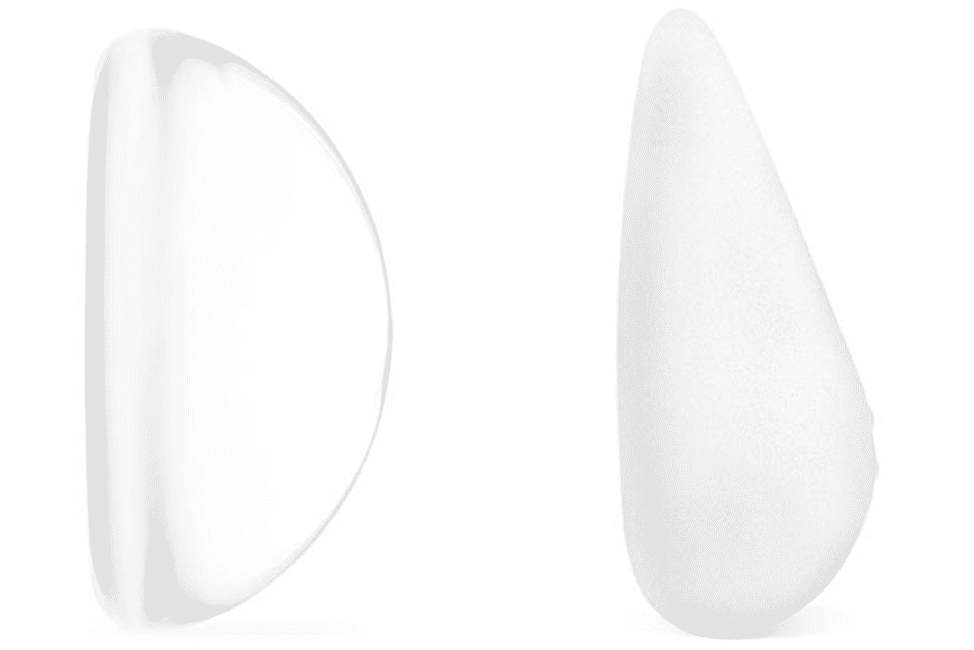 Anatomical implants are tear drop shaped, similar to the anatomy of the normal breast. These implants were primarily used in breast reconstruction, but have since made their way into cosmetic breast augmentation. When looking at an anatomical implant from the front, it appears oval in shape. If viewed from the side, it appears to have more volume at the bottom, thus making it project in a more conical fashion. It is possible for anatomical implants to “flip”, or turn, in the pocket hence all anatomical implants come with a textured surface which allows for tissue adherence and helps to keep the implant in their proper position. The skill and experience of the surgeon in using anatomical implants is also a factor in preventing the implant “flip” by creating a correct sized pocket. However, weight fluctuations and pregnancy may result in the expansion of the pocket surrounding the implant thus causing the implant to “flip”. In this case surgical intervention is required to tighten the pocket.
Anatomical implants are tear drop shaped, similar to the anatomy of the normal breast. These implants were primarily used in breast reconstruction, but have since made their way into cosmetic breast augmentation. When looking at an anatomical implant from the front, it appears oval in shape. If viewed from the side, it appears to have more volume at the bottom, thus making it project in a more conical fashion. It is possible for anatomical implants to “flip”, or turn, in the pocket hence all anatomical implants come with a textured surface which allows for tissue adherence and helps to keep the implant in their proper position. The skill and experience of the surgeon in using anatomical implants is also a factor in preventing the implant “flip” by creating a correct sized pocket. However, weight fluctuations and pregnancy may result in the expansion of the pocket surrounding the implant thus causing the implant to “flip”. In this case surgical intervention is required to tighten the pocket.
Each shape has its pros and cons and some surgeons prefer one form over the other, whilst others will use different types depending on the patient’s own characteristics. By and large, both produce excellent results when chosen based on patient’s suitability.
Breast implants are selected based on the patient’s chest shape, breast width, breast height, position of the infra-mammary fold, breast tissue, areola position, breast ptosis (droopiness) and possible breast asymmetries. Furthermore factors such as width of shoulders and hips also influence the implant size selection. The above parameters will provide the basis for discussion of options, goals and possible surgical outcomes. At your consultation, you will be able to see, feel and even try on the implants.
Both round and anatomical implants come in different profiles, heights and width. All these factors impact the final look.
Breast Implant Profiles
The most commonly misunderstood characteristic of breast implant is its Profile or Projection which refers to how much an implant projects forward from the chest wall when standing. Implants are available in several different profiles including low profile (rarely used), moderate profile, moderate plus profile, high profile, and ultra-high profile. Implants of same size volume cc (cubic centimeter) can have different base width and Profile. In round implants, the higher the profile gets, the smaller the width of the breast implant becomes and vice versa. Many times, the width and profile of implants vary depending on the implant manufacturer. Below profiles are based on Mentor Implants.
Low Profile – The low profile breast implants have the least projection and the widest base. These are suitable for patients with wider chest frame who prefer relatively “flat” and minimal projection. This profile is rarely used in cosmetic breast surgery procedures.
Moderate Profile– The moderate profile breast implants have slightly more projection than low profile but retain a similarly wide base-width. Not suitable for narrow or small chest frames. Not commonly used.
Moderate Plus Profile– The moderate plus implants offer more projection and narrower width than standard moderate implants. This implant profile is favored by patients who prefer a subtle upper breast volume and a “wider” look. In my practice, this is the most commonly used implant profile after high profile.
High Profile– The high profile implants yield fuller upper breast volume compared to moderate plus, and have a narrower base-width.One main benefit of this profile is that patient can opt for a larger natural size, without increasing the risk of visible wrinkles and rippling on the side of their breast. compared to opting for same size in moderate plus. In my experience this profile provides a more “youthful” look and is preferred by many of my patients.
Ultra High Profile– This is the implant profile with the highest projection and narrowest base. This is usually preferred by patients who have a small chest frame and prefer larger size implants with maximum projection and upper fullness of breasts. This implant profile offers the least natural looking results and not commonly used in my practice.
To give you a better idea of the differences between profiles, here is a comparison between moderate, moderate plus and high profiles of 300cc Mentor Memory Gel Implant.

When it comes to Teardrop shaped or anatomical implants, these are measured in width and projection, but also in height. There are three different heights, low, medium and tall height. Here we’ll focus on various profiles of medium height implants as these are most commonly used. Similar to round implants, Mentor Memory Shape, Anatomical implants come in moderate, moderate plus and high profiles. Here you can see how they differ in projection.
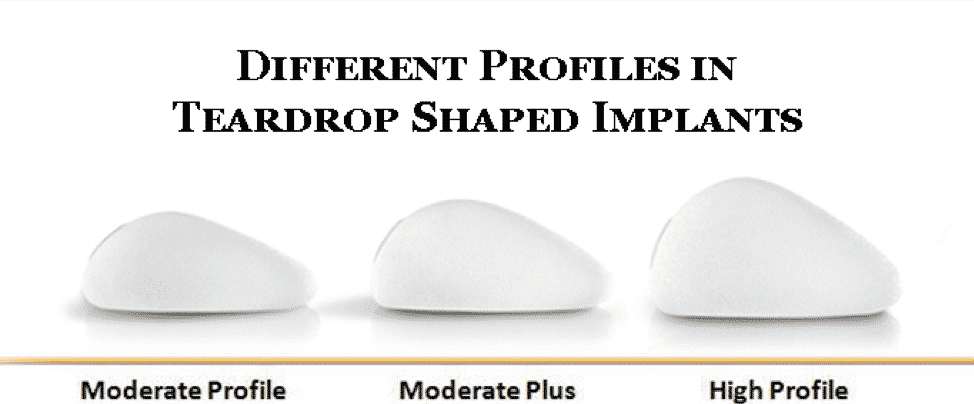 Regardless of Shape, NOT all implant profiles are suitable for every patient, hence guidance from your plastic surgeon is important in your decision making.
Regardless of Shape, NOT all implant profiles are suitable for every patient, hence guidance from your plastic surgeon is important in your decision making.
The Right Implant Shape & Profile For You
The goal with breast augmentation should be creating proportion between chest area and rest of the body. Many times, opting for too small implants can be as unnatural as having large implants. Creating proportion should be the main objective of the implant selection process.
The ideal implant shape and profile differs from patient to patient based on the following considerations:
- Patient’s ribcage, chest anatomy and measurements
- Patient’s desired upper breast tissue fullness and overall look
- Amount and distribution of breast tissue, i.e. more lower breast tissue or equally distributed
- Placement of breast implants, i.e., Submucular, Subglandular, Subfascial or Dual plane
- Elasticity of breast tissue and skin
- Implant size
Most patients have an idea about what they want in terms of fullness, size and even the type and shape of implant. But you’ll be surprised to know that many times, after their consultation, patients end up selecting a completely different implant shape or profile as what they initially thought they preferred.
In general, the higher the implant projection, the narrower the implant width becomes, and with less projection the base becomes wider. Patients with narrow breast base-width may benefit more from a high profile implant while individuals with wider breast-width may prefer the Moderate plus profile. It should be noted that normally there is more size limitation with moderate or moderate plus implants compared to High profile.
To better understand what implant types, profiles and sizes fit your frame and to know your limitations, a thorough consultation with an experienced plastic surgeon is vital. It is during this meeting that you can discuss your goals with wanting this surgery, and what your preferences are in terms of outcome
Breast Implant Sizing
The size of an implant is determined by factors such as its width, height (in anatomical implants) and profile or projection. CC (cubic centimeters) is the notation used for measuring the volume of the implant.
The most important consideration in breast implant sizing is matching the breast implant width with the natural base-width of the breast. In some cases, your surgeon would need to alter the breast base-width, but there is limitation as to how much this can be adjusted, thus the width of the implant should fit your breast base-width as much as possible. If the breast implant width significantly exceeds the natural breast width, surgery will result in unnatural shape and unnecessary complications, where some can be difficult to correct. The other factor to consider is the profile or projection of the implant, and this comes hand in hand with the breast implant width. The Higher projection an implant has, the narrower the implant width becomes and the wider the implant width, the lower projection the implant has. That’s why both implant width and profile should be considered when selecting a size.
It is important to keep in mind that Breast Implant size is a long-term life decision, you are not looking for short-term satisfaction, instead you should consider your lifestyle and think about how your breasts will look in the future, as much as how they will look in the first year after surgery and select a size that would provide you with a long-term satisfaction. This decision can be overwhelming for many patients, and ultimately it is your choice, but remember that your surgeon is there to guide you through this process and help you make the right decision.
Mr Rezai only uses the highest quality implants for all of his procedures. He will discuss the type he considers most suitable for you at your consultation. Mr Rezai encourages all of his patients to research each of the implant types and read through the manufacturer’s warranty to ensure his patients make fully informed decisions. For further information about the brands of implants Mr Rezai uses at his practice, please refer to Breast Implant Brands page on the website.
We advise that you visit the IRG’s web site at www.silicone-review.gov.uk and also download the Medicines and Healthcare products Regulatory Agency (MHRA) Leaflet to assist in making an informed choice about breast implants.
Breast implants - types of incision and location of breast implant pocket
As with most surgical procedures, there are many available options depending upon the patient’s wishes, technical considerations and Mr Rezai’s advice. At consultation, Mr Rezai will advise upon the best option for you.
The trend in plastic surgery is to minimise scarring by remote placement of access incisions. The position of the incision is important and will be discussed with the patient, highlighting the pros and cons of each approach. There are four commonly used types of incisions: inframammary crease, periareolar, axillary and umbilical.

Inframammary Incision – In the natural crease under the breast
- This is the most common type of incision.
- The incision is made just above the imframammary crease, and will be no more than 3-4 cm in length.
- This incision is very popular amongst surgeons because it gives complete visualisation of the subpectoral plane and offers a great deal of control over placement of the implant.
Periareolar Incision – Around the lower half of the areola
- This approach is favoured by some surgeons, it involves an incision within the brown or pink pigmented areolar tissue and when it heals well, the scar is almost invisible. However, should the patient develop excessive scarring for any reason, then it will be particularly noticeable.
- It is also associated with a higher likelihood of breast feeding difficulties than the other incision options as periareolar incision involves cutting through the breast tissue. This may also increase the risk of change in nipple sensation.
- If a patient is undergoing simultaneous mini uplift or areola lift, the Periareolar Incision is a good approach since the two procedures may share the same incision.
Transaxillary Incision – Through the armpit (axilla)
- This approach involves inserting the implants via a small incision in the armpit. The final scar, if healed well, will be generally well hidden.
- In these circumstances most surgeons would place the implant behind the pectoral muscle. This procedure is known medically as Trans-Axillary Retropectoral Augmentation or by its acronym TARPA.
- There are many disadvantages to the transaxillary incision hence it is not favoured by many surgeons.
Periumbilical Incision – Through the tummy button
- Periumbilical incision is made in the belly button or umbilical channel.
- It provides the worst control for dissection of the pockets and increase the risk for bleeding and infection.
- This approach is the least utilised technique.
Having made the incision, the pocket is then created into which the implant is inserted. The placement of the pocket is determined by your breast anatomy. Mr Rezai will discuss this with you in more detail during your consultation.
There are essentially four locations within the breast where implants can be placed, each with its advantages and disadvantages. These are regularly referred to as subglandular, submuscular, dual plane and sub-fascia placement. The choice of which placement to use is a function of the patient’s anatomy, their lifestyle, and both patient and surgeon preference.
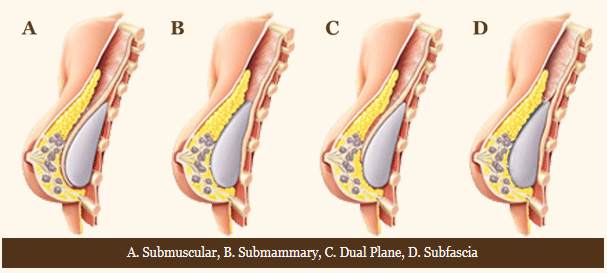
Submuscular / Subpectoral pocket – Most commonly referred to as “unders”
In submuscular placement the implant is positioned behind the pectoralis major muscle, i.e. the implant lies between the muscle and the ribs. The upper 2/3 of the implant is covered by the muscle and the remaining 1/3 will be under the muscle fascia which is a sheet of connective tissue made of collagen covering the pectoral muscle. It is anatomically impossible for the whole of the implant to be fully covered by the pectoral muscle. This pocket is more appropriate when the patient has little or no breast tissue to cover the implant since there is less risk of the implants being seen, providing a more natural slope, with the implants being less palpable.
Suitability: patients with little or no breast tissue.
The advantages of submusclar implant placement include:
- Decreased risk of capsulsar contracture.
- This placement helps to camouflage the edges of the implant, as well as ripples in the implant. While visible rippling is possible with all four placements, having submuscular placement has the least risk of visible rippling.
- The fascia serves as support to the lower pole, thus, lower risk of bottoming out
- Better mammogram readings when compared with subglandular placement.
- If a woman later undergoes a change in weight, perhaps due to pregnancy, the muscle supports the implant and so the breasts and implants are less prone to sagging.
The disadvantages of submuscular implant placement include:
- Increased post-operative pain and discomfort.
- Breasts sit high up for a longer period of time, until the muscle relaxes and allows the implant to settle in place.
- A submuscular pocket can be less advisable for women of an athletic build, since their pectoral muscles can be somewhat overdeveloped, and the implant will distort when making certain types of movement, such as during swimming or getting out of a pool.
Submammary / Subglandular Pocket – most commonly referred to as “overs”
In subglandular placement the implant is positioned over the pectoralis major muscle and under the breast glands (mammary). It is probably the most commonly used procedure. However, this placement is only suited for women with adequate breast tissue, as in women with little or no breast tissue, the subglandular placement is likelier to show the ripples and wrinkles of the underlying implant.
Suitability: Patients with adequate breast tissue (glands) to cover the implant.
The advantages of subglandular implant placement include:
- Easier procedure compared to other placements.
- May provide a slight degree of lift, in breast with mild ptosis (sag), however, it is important to bear in mind that the implant is supported only by skin and breast tissue and many times an uplift is needed in the future, especially if larger implants are used.
- Many women who lift weights opt for sub-glandular placement. This is mostly due to the fact that when the pectoral muscles are flexed, the implant does not become distorted in shape.
- Less recovery time, with less post-operative discomfort/pain, since the muscles are left intact.
The disadvantages of subglandular implant placement include:
- Ripples are more easily seen and felt, especially in women starting with little or no breast tissue. In these cases, there is very little tissue to cover the implant.
- Potential for greater visibility of the upper edge of the implant.
- More difficult to read mammograms thus more pictures/views are required.
- Capsular contracture (hardening of the scar tissue around the implants) rates are highest in women with implants placed over the muscle.
- Bottoming out is a larger risk with this placement when compared to other three placements.
- Subglandular placement may give a more “fake”, augmented look, if chosen for patients without indication.
Dual Plane / Bi-Planar Pocket – Most commonly referred to as “partial”
Dual plane placement is sometimes also referred to as partial submuscular placement and is a method employing the advantages of both submuscular and subglandular positioning. In dual plane placement the upper 2/3 of the implant is beneath the pectoralis major muscle, while the lower part of the implant is in the subglandular plane, i.e, over the muscle but under the glands. The surgery is somewhat more complex than that required for other types of placements, however dual plane placement of implants offers a very natural look and feel together with excellent muscular support and fullness. The feel of dual plane implants tends to be firm at the top of the breast and softer and more pliable at the bottom, very much like that of natural breasts, and the coverage of the pectoral muscle helps to conceal any signs of the implant shell.
Suitability: This placement is suitable for patients with lack of upper breast tissue but with adequate tissue in the lower portion of their breast.
The advantages of dual plane implant placement include:
- Decreased risk of capsulsar contracture.
- As with submuscular placement, dual plane, helps to camouflage the edge of the implant, as well as ripples of the implant, except for the lower 1/3 pole, which is not covered by the muscle/fascia.
- Provides a more natural shape to the upper part of the breast.
- Better mammogram readings when compared with subglandular placement.
The disadvantages of dual plane implant placement include:
- More post-operative discomfort.
- Breasts may sit a bit higher at first until the muscle relaxes thus it takes longer to see the outcome
- Similar to submuscular placement, there is a risk of Implant distortion in athletic patients with very strong pectoral muscle.
Subfascial pocket
In subfascial positioning, the implant is placed beneath the fascia of the pectoral major muscle, i.e. the implant lies between the muscle and its fascia. This approach combines several benefits of both submuscular and subglandular placement, which are the two most frequently employed pockets.
Suitability: Patients with adequate breast tissue but in need of added support for the implant.
The advantages of subfascial implant placement include:
- Decreased risk of capsular contracture.
- This placement provides a very natural result because it mimics the innate movement and contour of the tissue.
- It also provides added support from the strong fascia layer.
- Better mammogram readings when compared with subglandular placement as it isolates the implant from the breast tissue.
The disadvantages of subfascial implant placement include:
- More post-operative discomfort than subglandular.
- Other potential downsides relate to the fascia layer being somewhat thin, with the resulting possibility of it tearing and the implant position thus becoming subglandular.
- And also, whilst the fascia does provide support for the implant, it is not thick enough to provide any additional padding above the implant
Your size, shape and amount of breast tissue determine the type of implant placement suitable for you. Mr Rezai will discuss your options with you during consultation.
All placements should produce a natural look and feel if chosen according to patient’s suitability.
The procedure for augmentation surgery
- The operation is usually performed under general anaesthetic.
- It takes about thirty to forty minutes.
- Most patients stay in hospital for one night.
- If your work is not physical, you can expect to return to work after one week.
- Expect to be back to normal physical exercise within four to six weeks.
Following the operation
Following surgery some bruising and soreness is expected. The breasts will be firm, swollen and high up, at first, and will take several weeks to months, depending on the individual patient’s healing process, to settle and adopt a more natural position. However, it may take between 6-12 months for the breast to settle in their final shape, especially if the implants have been placed under the muscle.
You may be asked to sleep on your back, and to avoid straining or bending for a few weeks. You are also required to wear a surgical support bra continuously for up to four weeks, with exception of one hour per day. During the first week after surgery, activities should be restricted as otherwise it will result in unnecessary complications. Most patients resume normal activity after one week. Exercise and strenuous activity should be resumed no sooner than 6 weeks after your operation.
There will also be scarring. As with all scars, they will fade over time – in many women, they heal to form very faint white lines. However, it is important to remember that no surgical scar ever totally disappears.
Mr Rezai and his team will provide you with detailed post-surgery instructions to expedite your recovery. Should you develop any doubts or concerns following your treatment, however, they would encourage you to contact them straight away.
As a routine, Mr Rezai sees his patients at 7 days, 4-6 weeks, 9 month and thereafter annually after their surgery. He will guide and advise them on what to do at each stage to improve and maintain their results and how to identify possible complications if they were to develop.
Risk & complications of breast augmentation
Cosmetic surgery is amongst the safest of surgical operations. However, all patients must understand and accept that no such procedure is absolutely free from risk. Mr Rezai will discuss these risks with you at consultation.
Breast enlargement is extremely unlikely to impair lactation or breast-feeding, especially when implants are placed in the submuscular position. Mr Rezai does advise patients to undergo breast enlargement a least 6 months after you have stopped breast feeding. Breast appearance after childbirth varies in patients who have had augmentation prior to pregnancy. Some will return to their pre-pregnancy appearance while others will not.
A woman’s risk of developing breast cancer is not affected by breast implants, and to date there is no evidence to support a relationship between breast implants and breast cancer in humans.
Slight modifications in mammographic technique may be required for adequate visualisation of all breast tissue in augmentation patients. They should also perform monthly self-examination and become familiar with the new feel of their breast tissue. Self-examination is much more likely to detect a breast cancer in augmented patients compared to non-augmented women.
For detailed information regarding the risks and complications associated with Breast Enlargement, please refer to Risks and Complications of Breast Enlargement.
How long will the results of your breast enlargement last?
For the majority of patients, the results of their breast augmentation are long lasting. However, women who choose larger implants may find that their breasts tend to sag somewhat more as they become older and of course pregnancy and weight fluctuations are factors that may alter the size and shape of the breast.
It is also important to understand that breast implants of any type are not considered lifetime devices and cannot be expected to last forever. You will require future surgery for implant replacement or removal.






